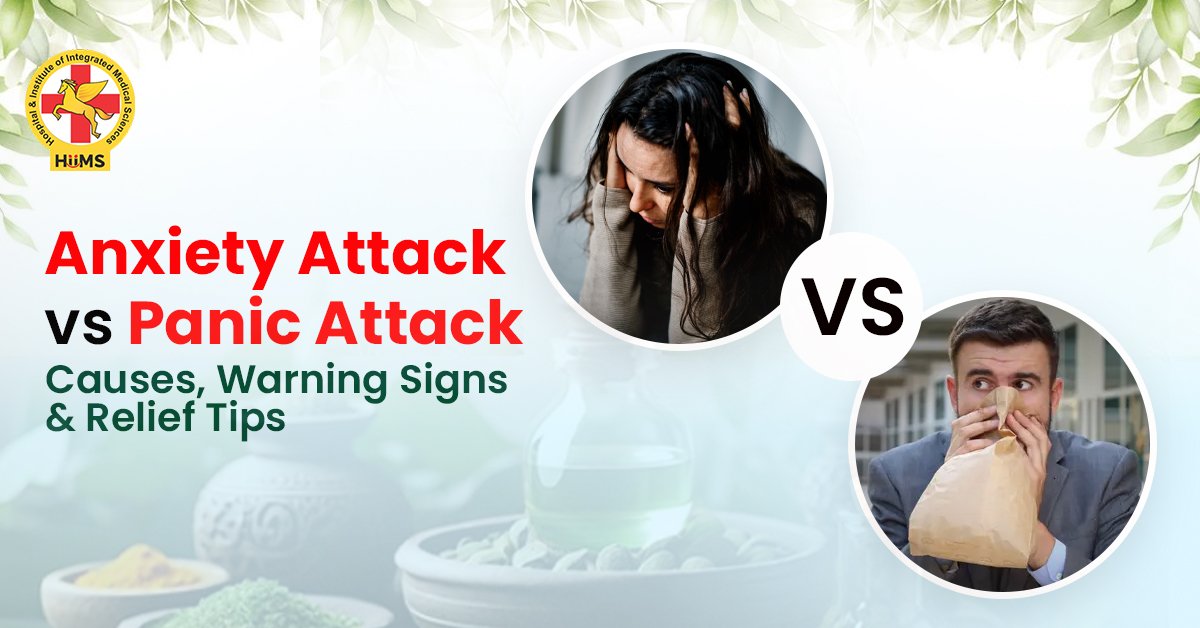Understanding the difference between an Anxiety Attack vs Panic Attack has become more important today than ever. People often use both words together, almost like they mean the same thing, but in real life, the experience, the feeling, and the way the body reacts can be very different.
Many people silently struggle with fear, tightness in the chest, sudden worry, or a strange rush of thoughts that come out of nowhere, and they don’t always know what to call it. When these moments keep repeating, it creates confusion, stress, and sometimes even shame. That is why breaking this down in simple language actually helps people feel less alone and more aware of what’s happening inside their mind.
In this blog, the main idea is to explain the difference between Anxiety Attack vs Panic Attack, how each starts, what symptoms come before them, and what truly helps during these moments. We’ll also touch on how natural healing and gentle therapies can bring relief. Jeena Sikho HiiMS, known for its holistic care and support, offers treatment for emotional and mental-health related concerns, including anxiety-related issues.
What Is an Anxiety Attack?
An anxiety attack is not actually a formal medical label, but people everywhere use it to describe a period of overwhelming worry and tension. It usually builds slowly. It may start with a small thought, a stressful event, or something that has been bothering you for days. Stress from work, relationships, or future worries can act as triggers. The body doesn’t rush into panic here; instead, it climbs gradually.
Anxiety attacks can last for several minutes or sometimes stretch into hours or even days. People feel restlessness, stomach discomfort, irritability, and mental overload. Since the feeling grows slowly, the signs of an anxiety attack often go unnoticed until it peaks. This is where holistic care like anxiety attack treatment becomes helpful because it focuses on calming the mind and body together.
What Is a Panic Attack?
A panic attack is more clinical in nature. It can strike suddenly, sometimes when a person is sitting calmly without any major trigger. The body reacts instantly with a racing heartbeat, chest pain, trembling, dizziness, or the feeling that something terrible is about to happen. It often peaks within 5 to 20 minutes, though the aftereffects can stay longer.
People may feel like they are losing control or even feel a strong fear of something very bad happening. Repeated episodes may indicate panic disorder. But not all panic attacks become a disorder; sometimes, the body is simply responding to accumulated stress.
Key Differences Between Anxiety Attacks and Panic Attacks
Onset & Trigger: Anxiety attacks grow slowly due to stress or worry. Panic attacks strike suddenly, sometimes unpredicted.
Intensity: Anxiety symptoms are milder but longer. Panic symptoms are intense and frightening.
Duration: Anxiety can stay for hours or longer. Panic occurs quickly.
Diagnosis: Anxiety attack is not a clinical diagnosis; panic attack is medically recognized.
Emotional Experience: Anxiety brings constant worry. Panic brings sudden terror.
Causes & Risk Factors
Causes of Anxiety Attacks
Chronic stress, overthinking, unstable routine, and long-term worry are some major causes of anxiety. Personality and temperament also play a role. People who naturally think a lot may be more prone to anxiety attacks.
Causes of Panic Attacks
Panic attacks often occur due to a sudden overactivation of the body’s fight-or-flight response. Family history, phobias, medical conditions, or extreme stress can increase the chance of panic attacks.
Warning Signs and Symptoms
Common Symptoms: Sweating, trembling, racing heart, nervousness, and restlessness.
Anxiety-Specific Signs: Muscle tension, sleep issues, irritability, and difficulty concentrating.
Panic-Specific Signs: Impending doom, chest tightness, shortness of breath, tingling, and depersonalization.
Treatments and Relief Tips
Acute Relief
Practice slow breathing, grounding (walking barefoot on green grass for 45 minutes to 1 hour), walking, or shifting focus. Remind yourself that the feeling will pass.
Long-Term Management
Holistic care like anxiety attack treatment at a trusted anxiety treatment hospital can bring deeper support. Herbs like ashwagandha, brahmi, jatamansi, and tagar help reduce inner restlessness and promote emotional balance.
Lifestyle habits like morning sunlight, warm meals, mindfulness, good sleep, and short breaks during screen time make a meaningful difference.
Professional Help at Jeena Sikho HiiMS
If these symptoms keep interfering with life, Jeena Sikho HiiMS offers guidance, therapy support, and natural treatment options for anxiety and panic concerns.
Conclusion
Understanding Anxiety Attack vs Panic Attack helps you clearly see the difference between slow-building worry and sudden intense fear. Both experiences are valid, and both need support. With the right approach, natural therapies, and gentle daily habits, long-term balance becomes possible.
If you feel these symptoms keep repeating or affecting your routine, reach out for help. Jeena Sikho HiiMS is here to guide you with holistic care and support. For assistance or appointments, call us at +9182704-82704 or email care@jeenasikho.com today.
FAQs
Q1. What are common early signs of anxiety attack?
Early signs of anxiety attack often show up as worry, restlessness, and trouble focusing for long.
Q2. What usually causes anxiety attacks in daily life?
Daily pressure, overthinking, and long-term stress become major causes of anxiety.
Q3. Where should someone go for proper anxiety or panic care?
A dedicated anxiety treatment hospital offers evaluation, guidance, and long-term support.
Q4. Can lifestyle changes reduce frequent anxiety episodes?
Regular sleep, warm meals, and mindful habits support the mind and naturally reduce causes of anxiety over time.
Q5.How does holistic care help with anxiety and panic issues?
Therapies and herbs used in anxiety attack treatment calm the nervous system and support emotional balance.


